ISSN ONLINE(2319-8753)PRINT(2347-6710)
ISSN ONLINE(2319-8753)PRINT(2347-6710)
Amol Bhadange 1, Sudipta Giri 2
|
| Related article at Pubmed, Scholar Google |
Visit for more related articles at International Journal of Innovative Research in Science, Engineering and Technology
Wireless sensor network is very essential in today’s life. The rapid growth of mobile technology is increases in recent years. And thus this is challenging job for industry to develop an efficient network which suits in today’s technology. The users are main factor in this technology, without users the network is incomplete or rather incomplete technology without users. The main motto behind this paper is to design and implement a generalized sink model which supports users in sensor field. With the help of some parameters it is easy to evaluate sink model. Also, analysis of this model is to be done based on some evaluation criteria, which helps to make the model successful and meaningful. The paper is divided into 5 sections. First one is introduction, second one is related work, third one is proposed design, and fourth one is experimental and results and final one is conclusion and future work.
Keywords |
| Remote user, Mobile communication, Mobile users, Wireless sensor networks, multiple static sink. |
INTRODUCTION |
| Wireless mobile technology has more demand in today’s culture. Mobile network has more popular now days because of its availability and ease of use. |
| The proposed model depending upon mainly the sink capacity, more the sink less energy will consume at sink node. There are many existing techniques or models of wireless sensor network which supports the mobility as well as demand of users. No matter, some models also support mobile users but due to single static sink in the network create some limitations. To overcome these limitations there is need to develop some common generalized model which is compatible to both remote users as well as mobile users. So there is idea to develop such model which can increase the network life by avoiding extra congestion in the network. And here the idea came into mind to develop a generalized sink model which have a multiple sinks or base stations that creates some difference in the network. The generalized sink model helps to improve network life and also up to some extent decreases the energy consumption. |
RELATED WORK |
| While referring the paper, et. al. [6], the new concept called as hot spot problem came into picture. The paper suggested that to overcome the hot spot problem, number of sink must be in more number rather than a single sink. Same knowledge is given by paper, et. al.[2], they proposed multistage switching network to increase the life of sink and ultimately the network life. And also up to some extent they can solve the problem of traffic by dividing the network into one or more domain and this will reduce the hot spot problem. |
| Other one, et. al [3], proposed distributed energy-efficient deployment algorithms which helps to improve the energy of network. To support the algorithm the technique uses cluster, this helps them to analyze the structure of network and also helps to decrees energy consumption near base station. |
| On the basis of sensor field development, et. al. [4] and et. al. [5] developed algorithm for how to collect sensing data from all sensor nodes, provides algorithm for multidimensional analysis for jumping sensors respectively. The existing model, et. al. [1], assume mobile user itself as a mobile sink. The user can gather data from sensor nodes via network. If the sink is dynamic the user selects sensor node as a dynamic. |
PROPOSED DESIGN |
| The proposed design of my communication protocol is as follows. |
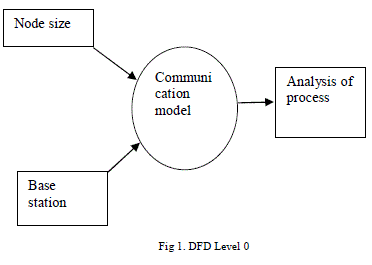 |
| It is observed that from fig.1 there is need of node size to define number of users and base station is acts as a gateway to communication model. And finally will get the output with the help of some observable parameters like network size, user speed, and number of multiple static sinks. There is need to extract this DFD level 0 to DFD level 1. To understand this proposed design more in detail. |
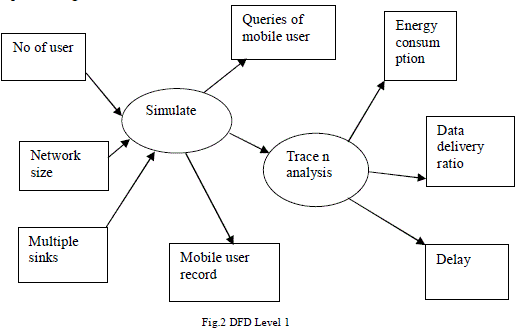 |
| It is observed that from fig.2 number of users is taken to simulate with the help of speed. To decide the topology of network, network size is taken as parameter. Multiple sink is act as a gateway between users and sensor field. During the simulation process, queries of mobile users as well as mobile user’s record are stored in mobile user management table. This helps to recognize the information of mobile users in the network. |
| After simulation process will get the parameters output, with the help of trace n analysis process will plot the graph against energy consumption, data delivery ratio, delay by using xgraph. All this proposed design will be implemented in ns2 simulation tool. |
| The implementation results from, et. al. [1], shows that, the model single static sink with legacy network has more energy consumption, lower data delivery ratio, and longer delay this is because, hop count of their data gathering tree increases. Same is for single static sink model with sensor network also. |
| To overcome the problem of energy consumption there is need to increase of number of sink. This is my first propose work, to increase the domain size. The second propose work i have decided to verify the claims of the paper which i refer by using same parameters like network speed, network size. And also there is scope of varying data packet rate like 32-128 bytes in the future. As compared with 64 bytes rate, will check what it affects on energy consumption or delay. |
EXPERIMENTAL RESULT |
| With the help of proposed design, i compare both models (single static sink model and multiple static sink models) results with respect to their parameters. Firstly i have taken 2 scenarios. In first scenario i have taken 11 nodes, out of that 3 nodes are movable and they send packets to the sink. In this scenario for understanding purpose there are 2 sink. Sinks are receiver. |
| Here i have compared 14 parameters for single and multiple sink scenarios. As seen from fig.3 there is slightly difference between delay of single sink with respect to delay of multiple sink, this is because of node movement is very nearer to each other. Also there is slight change in packet delivery ratio, but there is difference in energy consumption. As compared to single sink model network energy decreases in multiple sink model. Also residual energy is also decreases in multiple sink as compared with single sink. And this is a very good sign as our network consumes less energy, ultimately that will results to increase network life. |
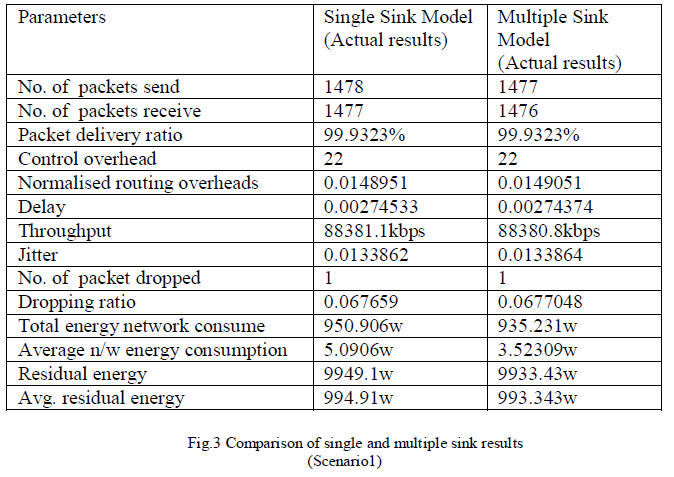 |
| Along with these results individual node wise energy consumption results also plotted. As seen from fig.4 the individual node wise energy slightly change with respect to both models. Very minor energy difference is there; due to node movement is very slow and nearer to each other. In second scenario will see the difference in energy consumption of individual node. The node near to sink will consume more energy than those nodes are away from sink. |
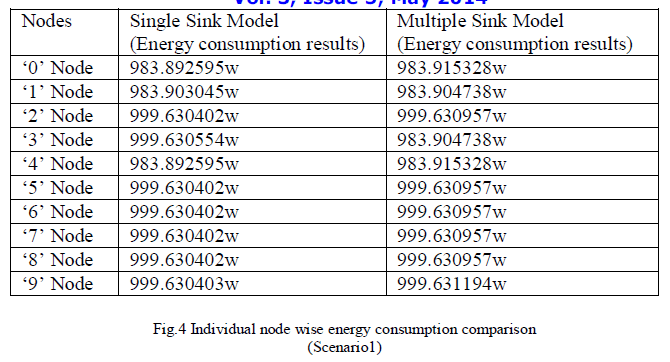 |
| In the second scenario the distance between two sinks is increased and the direction of nodes slightly changed. Some nodes are nearer to the sink and some are far away from sink. As seen from fig.5 will see the difference in delay and also our packet delivery ratio is also improved as compared with scenario1.The total energy consumption of network is reduced as compared with single sink model. In both the scenes the energy consumption of network is less as compared with single sink model. Hence it is prove that by using multiple sink, our network life is more than by using single sink. |
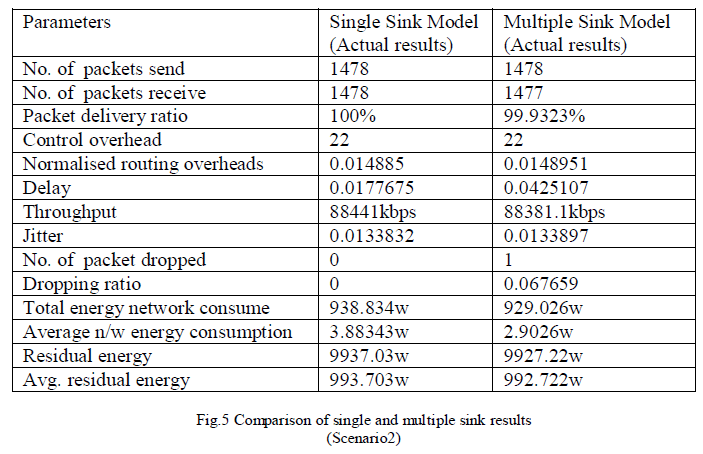 |
| As seen from fig.6 will get difference in individual node wise energy. Those nodes are near to sink they consume more energy than those nodes are away from sink like scean1. But in scean1 no node movement as such, but in scean2 there is node movement, some layer of nodes are away from sink, and some are nearer to sink, and for 2 to 3 nodes mobility is given such that to understand individual energy loss. From these two scenarios it is observed that will get better delay, better packet delivery ratio and less energy consumption in multiple sink model as compared with single sink. |
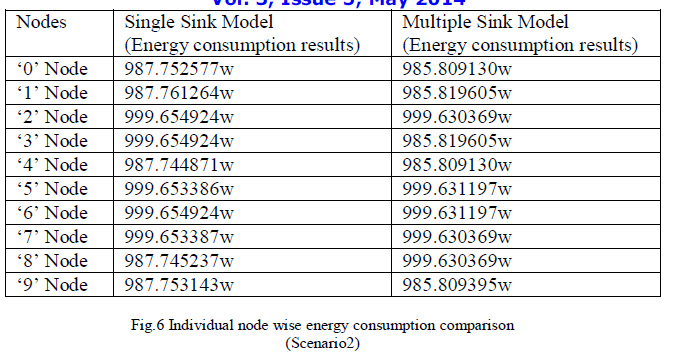 |
| Still i am working on some more results. More and more results gives the current model is very much useful as far as sensor network point of view and also for user’s point of view. |
CONCLUSION AND FUTURE SCOPE |
| The current protocol allows the multiple static sinks to perform the function as gateway for users in other networks via the legacy networks. Also in the futu`re there is scope of try to solve mobility issue. We could try to make sink movable or dynamic instead of static. |
References |
|